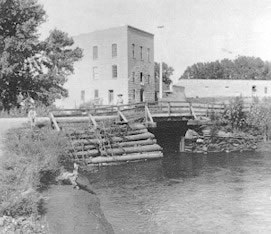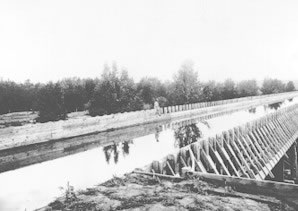Irrigation Projects
The man who founded Littleton came here because of the need to irrigate this arid land.

The Rough and Ready Flour Mill. Date unknown.
Richard S. Little was an engineer working primarily for railroads in the upper Midwest, when he learned of opportunities in the new Colorado gold fields. He left Wisconsin in 1861 and upon arrival in Denver was soon hired by the Capital Hydraulic Company to supervise construction of a ditch to supply the booming town of Denver with irrigation water. The inlet, off the South Platte River, was near the present location of downtown Littleton. However, Little quickly realized that the original engineer on the project had miscalculated and that a new inlet nearly four miles upstream would have to dug. Financial difficulties soon postponed construction on what would become known as simply, "city ditch", but when completed in 1870 it became the primary source of water for Denver for a quarter century.
In the meantime, Little had grown fond of the area of the abandoned ditch and homesteaded nearby. Not letting all that work go to waste, he and several neighbors channeled it back into the Platte and built their Rough and Ready Flour Mill along its course. Though never used directly for irrigation, the Rough and Ready Mill Race helped process the agricultural products of the region for more than 80 years.
Thus began an unending struggle by settlers to farm the land all up and down the South Platte River valley. By 1883, when concern over the amount of water being taken from the Platte caused adjudication hearings to establish water rights, some 250 ditches were in use, 30 of these in the Littleton area. City Ditch was assigned priority #1, the Rough and Ready was #2, and five other area ditches were among the first ten, showing that farmers in the Littleton area were early leaders in irrigation. The City Ditch was one of the first irrigation canals in Colorado. Work began on the ditch in 1865 when John W. Smith contracted to construct it for a sum of $10,000. It was completed in May, 1867, and was then given priority #1 to take water from the South Platte River.

Highline Canal, Platte Canyon, 1884. Photo by William Henry Jackson, courtesy Denver Public Library, Western History Collection.
The Nevada Ditch, which parallels City Ditch on the west bank of the Platte was begun in 1861 and is still in use today. In fact, ten ditches in use in the Littleton area before the turn of the century are still active. Besides Nevada and City, the others are Hayland, Selzell, Fairview, Old Time and Garden Ditches off of Deer Creek, Last Chance Ditch on the Platte and Littleton Heights Ditch in Slaughterhouse Gulch. And the largest ditch ever constructed was the Highline Canal. Begun in 1879, it was 74 miles long, an average of thirty feet wide, cost $650,000 and took four years to complete. It was designed to carry nearly three-quarters of a billion gallons of water per day, but actually averages only one-tenth of that -- 71 million gallons. By comparison, City Ditch carries 16 million gallons, Nevada Ditch, 12 million.
In this modern era of municipal water systems, you may be surprised to learn that so many ditches still exist, and that they provide 90% of the water for irrigation along the front range. Only 10% of irrigation water comes from potable sources, and this is mostly for suburban gardens. For safety reasons, many active ditches today are covered. You can often locate the course of an existing or abandoned ditch by looking for lines of trees running perpendicular to the slopes of hillsides. You can spot City Ditch as it flows just west of the Arapahoe County Courthouse, and Highline Canal passing underneath Santa Fe Drive about a mile south of highway C-470.
Irrigation ditches played a major role in the development of the South Platte River valley, and particularly the area around Littleton. With its Rough and Ready Mill, Littleton was, for many years, the agricultural center of the valley. Crops such as wheat, oats, barley, corn, hay, rye and numerous garden vegetables simply would not grow in this region without irrigation water and the ditches that were dug bring it near the farms and ranches. As illustrated above, even today we could not treat enough water and transport it through the city's pipes to meet agriculture's needs.
Bibliography
Littleton Independent. Littleton Independent Publishers, 1888- .
Littleton Museum. Photographic Archives.
____. Vertical File: "Ditches, Canals, Irrigation".
McQuarie, Robert J. and C.W. Buchholtz. Littleton, Colorado: Settlement to Centennial. Littleton: Littleton Historical Museum and Friends of the Library and Museum, 1990.
O.L. Baskin & Co. History of the City of Denver, Arapahoe County and Colorado. Chicago: Baskin & Co., 1880.
Photographs courtesy of the Littleton Museum unless otherwise noted. To order copies, contact the museum at 303-795-3950.
Compiled by Pat Massengill
Updated April 2021 by Phyllis Larison